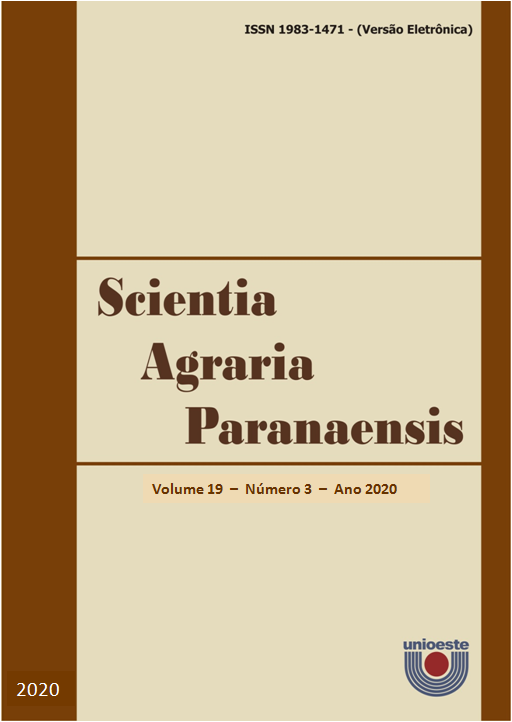Entomopathogenic fungi on the control of Sphenophorus levis in sugarcane crop
DOI:
https://doi.org/10.18188/sap.v19i3.24426
Agências de fomento
Centro Universitário Moura Lacerda
Resumo
Brazil is the largest producer of sugarcane crop in the world,but its production can be highly affected by the pest Sphenophorus levis. The entomopathogenic fungi Metarhizium anisopliae and Beauveria bassiana can be used for the control of this pest, but are not always effective in the field, lacking information on application methods, doses and formulations. We evaluate the efficacy of M. anisopliae IBCB 425 and B.bassiana IBCB 66 in controlling S. levis and other soil pests at sugarcane crop. The bioassay was conducted in a split plot design, where each of the 4 treatments were repeated 5 times and distributed over an area of 5.000 m2. The treatments for both fungi consisted of: Wettable powder (WP) formulation 225 g conidia ha-1, WP formulation 450 g conidia ha-1, granule (GR) formulation 10 Kg ha-1 and Control (no fungal application). WP fungi formulations were applied to the ratoon with a tractor using a ratoon cutter and an pesticide applicator. The GR fungi formulation was manually applied on the ratoons. The evaluations were performed after 21, 60 and 100 days of fungi application. B. Bassiana fungus reduced the pest population but did not differ from the control, however for M. Anisopliae fungus there were significant differences between treatments on damaged stems. The fungus M. anisopliae was effective in controlling S. levis larvae and adults in the field and WP formulation had faster action than the GR, the dose of 225 g conidia ha-1 was enought to reduce S. levis population.Downloads
Publicado
03-11-2020
Como Citar
VINHA, F. B.; DELFANTI, L. A. de A.; PAGLIARANI, V. D.; FERREIRA, V. S.; PINTO, A. de S. Entomopathogenic fungi on the control of Sphenophorus levis in sugarcane crop. Scientia Agraria Paranaensis, [S. l.], v. 19, n. 3, p. 280–288, 2020. DOI: 10.18188/sap.v19i3.24426. Disponível em: https://saber.unioeste.br/index.php/scientiaagraria/article/view/24426. Acesso em: 24 dez. 2025.
Edição
Seção
Artigos Científicos
Licença
Aviso de Direito Autoral Creative Commons
Política para Periódicos de Acesso Livre
Autores que publicam nesta revista concordam com os seguintes termos:
1. Autores mantém os direitos autorais e concedem à revista o direito de primeira publicação, com o trabalho simultaneamente licenciado sob a Licença Creative Commons Attribution que permite o compartilhamento do trabalho com reconhecimento da autoria e publicação inicial nesta revista.2. Autores têm autorização para assumir contratos adicionais separadamente, para distribuição não-exclusiva da versão do trabalho publicada nesta revista (ex.: publicar em repositório institucional ou como capítulo de livro), com reconhecimento de autoria e publicação inicial nesta revista.
3. Autores têm permissão e são estimulados a publicar e distribuir seu trabalho online (ex.: em repositórios institucionais ou na sua página pessoal) a qualquer ponto antes ou durante o processo editorial, já que isso pode gerar alterações produtivas, bem como aumentar o impacto e a citação do trabalho publicado (Veja O Efeito do Acesso Livre).
Licença Creative Commons
Esta obra está licenciada com uma Licença Creative Commons Atribuição-NãoComercial-CompartilhaIgual 4.0 Internacional, o que permite compartilhar, copiar, distribuir, exibir, reproduzir, a totalidade ou partes desde que não tenha objetivo comercial e sejam citados os autores e a fonte.


